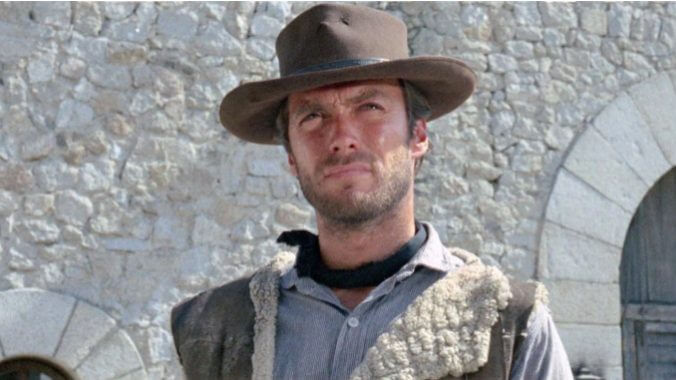Triple Threat: The Man with No Name Trilogy
Sergio Leone’s Western opus ushered in a new era of cinema

A story has a beginning, a middle, and an end. Maybe that’s why the trilogy is such a satisfying structure for so many epic series or curious corners of cinema history. This year in Triple Threat, Ken Lowe revisits another of cinema’s best trilogies each month, including some unofficial trilogies that have come to define a director, actor, or time in film history. You can follow the series here.
I have written before about the part of this trilogy that most people know. I’ve written about the films that adapt them, and about the genre legacy they were a part of. But I’ve never had occasion to write for Paste about A Fistful of Dollars, For a Few Dollars More and The Good, the Bad and the Ugly as a film trilogy—one cohesive whole. Sergio Leone’s Man with No Name Trilogy (also often called the Dollars Trilogy) isn’t the trilogy with the best action, or the most compelling interiority, or the most insight into the human condition. It is the trilogy with the mightiest and most unafraid horn section, though, and one that caused a seismic shift that still affects cinema in multiple genres to this day.
The Movies
The Italian producers who brought the Man with No Name Trilogy to life were clear with what they wanted right up front. Having just seen Akira Kurosawa’s Yojimbo, they set out to do a retelling as a Western, suggesting it to Leone. The $200,000 production couldn’t afford to offer the role to a big name actor like Leone’s first pick, Henry Fonda, so after numerous other American stars turned the role down, Leone went with a television actor known for starring in Rawhide. Clint Eastwood’s performance in Leone’s Westerns made him into an international superstar in a few short years, and then turned him into a top draw at the American box office when the Man with No Name Trilogy was released in the United States in quick succession in 1967.
Gallons of ink have been spilled, in the nearly 60 years since, about just what is different about these Westerns, besides the bizarre babel of tongues involved in the Spanish/West German/Italian production that shot the movie in Spain with actors from all of those countries. It comes down to tone. Anthony Mann once said that when making a Western, the creator has more leeway to make his story more mythical and archetypal. Leone took that viewpoint to an extreme, crafting an aesthetic and tone that makes his stories seem as if they are in some fabled version of the American West, and that this west somehow stretches lightyears in every direction.
It’s a feeling that is so palpable that it’s inspired countless other works to take the Western in an even more explicitly fantastical direction: Stephen King has directly referenced the Man with No Name Trilogy as an inspiration for his post-apocalyptic/fantasy/Western/horror/Harry Potter fanfic The Dark Tower. The acid Western El Topo takes the framework of a Leone Western and turns its archetypal desert wildernesses and Catholic religious iconography into a bizarre mystical journey.
The actual Man with No Name Trilogy films are dead simple by comparison.
In A Fistful of Dollars, Eastwood’s drifter, “Joe,” wanders into a town where two rival gangs are fighting, seemingly just over the right to be top dog of the middle of nowhere. In a beat-for-beat remake of Yojimbo, Eastwood plays both sides against each other before a final bloody showdown with the biggest bad of them all, Ramón (Gian Maria Volonté). Eastwood slipped into the poncho without a hitch, developing a persona that he would use for the rest of his decades-long career, before squandering it yelling at an empty chair that was supposed to be Barack Obama.
In For a Few Dollars More, Eastwood returns as Manco, a bounty hunter in competition with Lee Van Cleef’s Colonel Mortimer to track down the bank robber El Indio, also portrayed by Volonté. It’s an endlessly entertaining movie precisely because Eastwood and Van Cleef play off of each other so well, with Manco the brash up-and-comer and Mortimer the steely, competent, experienced old-timer with a bag full of sharpshooter’s specialty guns. It’s a setup that uses both actors perfectly, and gives Van Cleef the rare chance to play a protagonist in a career where he was almost always a sneering villain or a lackey.
And then, of course, there’s The Good, the Bad, and the Ugly, the one the most people have seen, and which has truly codified the tropes of the Spaghetti Western genre. During the Civil War, Eastwood is a nameless bounty hunter (they call him “Blondie” but he’s uh, not blond) who at first teams up with and then betrays the ruthless Tuco (Eli Wallach). In the course of carrying out his sadistic revenge against Blondie, Tuco runs into a wagon of dead Confederates, and one survivor who promises to tell him the location of $200,000 in stolen Yankee gold if he’ll just give the poor guy a drink of water. But Tuco only gets half the location, with Blondie hearing the other crucial piece of information. (It’s buried in a cemetery: Tuco knows which cemetery, Blondie which grave). Van Cleef returns as “Angel Eyes,” a Union soldier who moonlights as a ruthless paid assassin, and who also is seeking the gold.
-

-

-

-

-

-

-

-

-

-

-

-

-

-

-

-

-

-

-

-

-

-

-

-

-

-

-

-

-

-

-

-

-

-

-

-

-

-

-

-








































